The Best Dumbbell Bicep Workout Routine for Mass
Building bigger biceps doesn’t require fancy equipment or workout programming.
In fact, with just a set of dumbbells (ideally adjustable ones), you can create a simple, challenging, and effective dumbbell bicep workout that will add mass to your arms.
Whether you’re looking to grow your guns in the comfort of your own home or blast your bis with dumbbells in the gym, this article is for you.
In it, you’ll learn exactly how to get big biceps with dumbbells using five science-based tips and the best biceps dumbbell workout routine you can do to build bigger, stronger biceps.
- 5 Tips for Building Bigger Biceps
- 1. Change your upper arm position.
- 2. Vary your rep ranges.
- 3. Target the brachialis.
- 4. Focus on squeezing your biceps on every rep.
- 5. Control the eccentric.
- The Best Dumbbell Bicep Workout Routine for Mass
- Dumbbell Curl
- Dumbbell Preacher Curl
- Dumbbell Incline Curl
- Dumbbell Hammer Curl
Table of Contents
5 Tips for Building Bigger Biceps
There are two reasons people fail to build bigger biceps: they don’t eat properly, and they don’t train properly.
The first problem is a cinch—just eat enough calories and protein—but the second issue is more complex.
While the biceps are a notoriously stubborn muscle group that require a disproportionate amount of work to grow, you’ll gain biceps size and strength faster by following these five training tips.
1. Change your upper arm position.
If you want to build big, proportional biceps, exercise selection is key.
Research shows that using a range of biceps exercises that put your upper arms in varying positions relative to your torso ensures you fully stimulate every portion of your biceps muscles.
Don’t do what most people do, then—only train your biceps with, say, a standing or seated dumbbell curl, with the dumbbells at your sides. Do those exercises, but also do ones that put your upper arms slightly in front of your torso (like the incline dumbbell curl) and behind your torso (like the dumbbell preacher curl).
2. Vary your rep ranges.
To get the most out of your biceps training, it’s best to include a mixture of higher- and lower-rep sets in your workouts. For example, you could do about a third of your weekly biceps sets in the 6-to-8-rep range, a third in the 8-to-10-rep range, and a third in the 10-to-15-rep range.
This strategy allows you to trigger several different muscle-building “pathways” in your biceps. The heavier weights may be better for stimulating the type II muscle fibers that make up the majority of your biceps, while the higher-rep sets allow you to accumulate more volume with less joint stress.
3. Target the brachialis.
When most people talk about the biceps, they’re talking about a muscle known as the biceps brachii: the muscle on the front of the upper arm that’s made up of a long and a short head.
If you want to build outstanding arms, though, there’s another muscle that lies beneath the biceps brachii that you need to train called the brachialis.
A well-developed brachialis . . .
- Provides separation between the biceps and triceps
- Pushes up the biceps brachii, adding to their size, circumference, and “peak”
. . . which means it has an outsized impact on the appearance of your upper-arms.
Thus, if you want big biceps with well-defined “peaks,” your dumbbell bicep workout needs to include exercises that emphasize the brachialis, like the hammer curl.
4. Focus on squeezing your biceps on every rep.
There’s disagreement among experts about whether you can increase muscle activation—and thus growth—by simply concentrating on the muscle you’re training, but research shows that when it comes to the biceps in particular, the “mind-muscle connection” may have some merit.
In one study conducted by scientists at Lehman College, participants were able to increase the activation of the biceps during the biceps curl when the researchers reminded them to “squeeze the muscle” during each rep.
What’s more, participants who used this cue experienced twice as much biceps growth over the course of the 8-week study as participants who used a cue like “get the weight up.”
I like tips like these because there’s no downside. If focusing on your biceps when you train them works as demonstrated in the study I just mentioned, you get bigger biceps faster, and if it doesn’t, it’ll minimally help keep you concentrated on the work at hand versus something else, which makes training more enjoyable.
5. Control the eccentric.
Most people think the raising—or concentric—portion of a biceps exercise when you contract your muscles is more important than the lowering—or eccentric—portion.
That’s why many people slowly and deliberately contract their biceps as they lift the weight (or bust a gut to get it to the top) and then let it freefall to the starting position.
This is a mistake.
Research shows that controlling the eccentric portion of a biceps curl is a very effective way to boost muscle growth. By lowering the weight too rapidly, you’re short-changing your gains.
As a general rule, you should take the same amount of time to lift the weight as you do to lower it to the starting position—around one or two seconds for each is a good target.
The Best Dumbbell Bicep Workout Routine for Mass
Unless you have a home gym and want to squeeze in a relatively short training session, dedicating an entire workout to training only your biceps isn’t a good use of time. Plus, if you’re an experienced weightlifter, you’ll likely get better results by spreading your biceps training across two or three workouts throughout the week.
That said, here’s an effective biceps workout that can be incorporated into a larger workout (upper body or pull muscles, for example) or done by itself in 30-to-45 minutes or so.
Dumbbell Curl
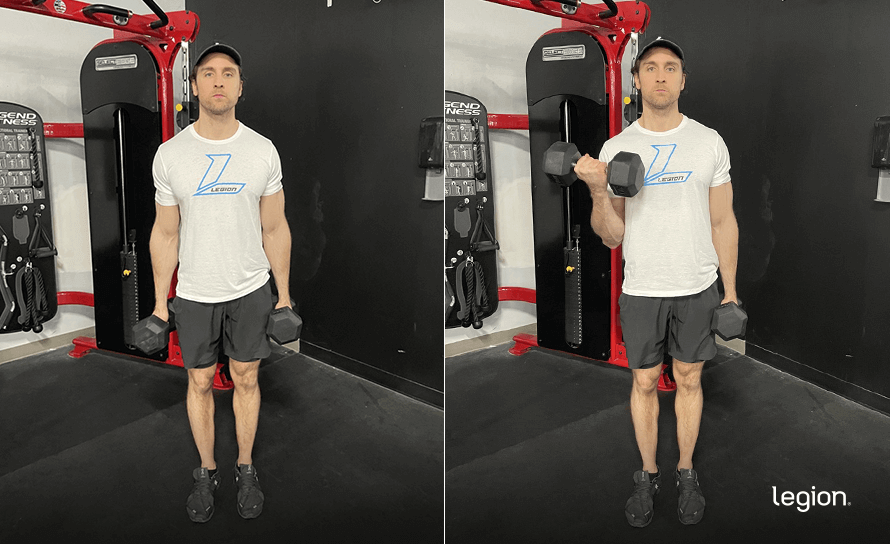
Sets: 3 | Reps: 6-to-8 | Rest: 2-to-3 min
Dumbbell curls are a staple in any dumbbell workout for biceps for a simple reason: They’re one of the absolute best exercises for training the biceps through a full range of motion. Many people also find they’re more comfortable than barbell curls.
How to: Stand up straight holding a dumbbell in each hand, with your palms facing each other and your arms hanging straight at your sides. Keeping your left arm at your side, flex your right arm and curl the dumbbell up until it’s in front of your right shoulder. As you lift the dumbbell, rotate your wrist so that your palm is facing toward your shoulder at the top of the rep. Lower the dumbbell to the starting position, and repeat with your left arm.
Dumbbell Preacher Curl
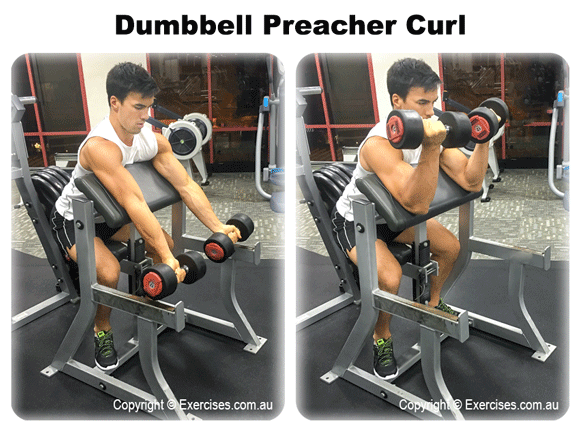
Sets: 3 | Reps: 8-to-10 | Rest: 2-to-3 min
The preacher curl prevents you from “cheating” by swinging the weight to the top position. While this makes the exercise harder, it also ensures your biceps are doing most of the work.
How to: Adjust a preacher curl station so that your armpits rest on the top of the pad when you’re sitting on the seat. Grab a dumbbell in each hand, place your elbows on the pad, turn your hands so your palms are facing you, then straighten your arms in front of you. Bring the dumbbells up to shoulder height, making sure to keep your elbows on the pad, then lower them to return to the starting position.
Dumbbell Incline Curl
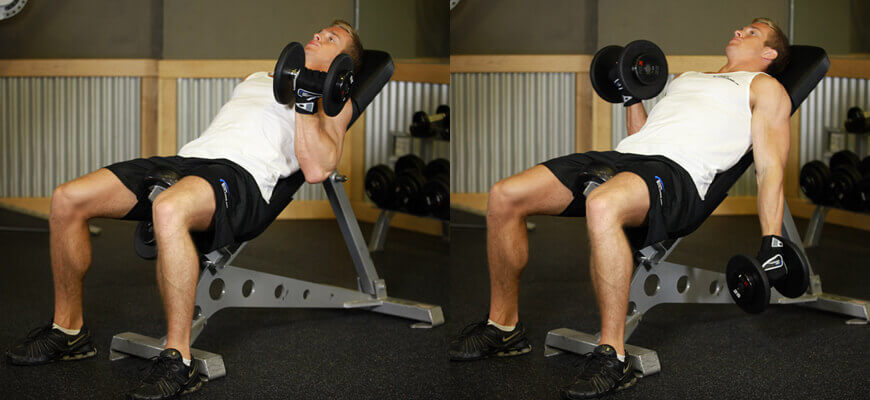
Sets: 3 | Reps: 8-to-10 | Rest: 2-to-3 min
The incline dumbbell curl trains your biceps when they’re behind your torso. Unlike with other biceps exercises, this places a high amount of tension on the biceps throughout the entire range of motion, which is important for developing balanced size and strength.
How to: Sit back on an incline bench set to 45 degrees. Hold a dumbbell in each hand and let your arms hang straight down with your palms facing each other. Without moving your left arm, flex your right arm and curl the dumbbell up until it’s in front of your right shoulder. As you lift the dumbbell, rotate your wrist so that your palm is facing toward your shoulder at the top of the rep. Lower the dumbbell to the starting position, and repeat with your left arm.
Dumbbell Hammer Curl
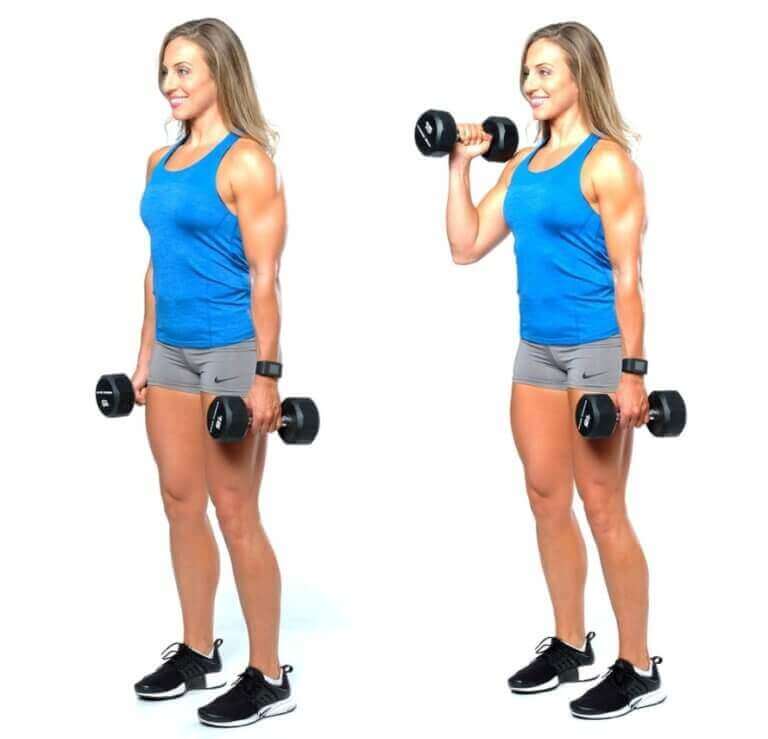
Sets: 3 | Reps: 10-to-15 | Rest: 2-to-3 min
The hammer curl emphasizes the brachialis—a small muscle that can help to push up the biceps brachii—making your upper arms look bigger and improving the appearance of your biceps “peak.”
How to: Stand up straight holding a dumbbell in each hand, with your palms facing each other and your arms hanging straight at your sides. Keeping your left arm at your side, flex your right arm and curl the dumbbell up until it’s in front of your right shoulder. Keep your thumb pointing toward the ceiling during the entire rep (don’t rotate your wrist). Lower the dumbbell to the starting position, and repeat with your left arm.
The post The Best Dumbbell Bicep Workout Routine for Mass appeared first on Legion Athletics.
https://ift.tt/2UpYugz June 28, 2021 at 06:00PM Legion Athletics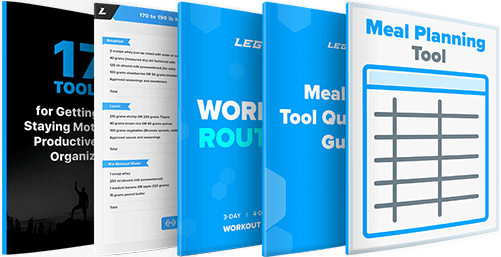
Comments
Post a Comment